Introduction
As the global fight against climate change intensifies, the shift toward renewable energy sources has become a critical priority. Among these, solar energy stands out as one of the most abundant and promising options for clean power generation.
However, despite the widespread adoption of traditional silicon-based solar panels, the search for more efficient, cost-effective, and versatile alternatives has never ceased. This is where perovskite solar cells (PSCs) come into play, representing a groundbreaking advancement in photovoltaic technology.
Over the last decade, perovskite solar cells have captured the attention of researchers and industry players alike, thanks to their remarkable efficiency and low production costs. With unique material properties that allow for exceptional light absorption and energy conversion, perovskite solar cells offer new opportunities to overcome the limitations of conventional solar technologies. Not only do they promise to significantly lower the cost of solar energy, but they also open up exciting possibilities for flexible and lightweight solar applications, from portable electronics to building-integrated photovoltaics.
As we explore the potential of this cutting-edge technology, it’s essential to understand why perovskite solar cells are poised to revolutionize the solar energy industry and help pave the way toward a more sustainable and energy-efficient future.
What Are Perovskite Solar Cells?
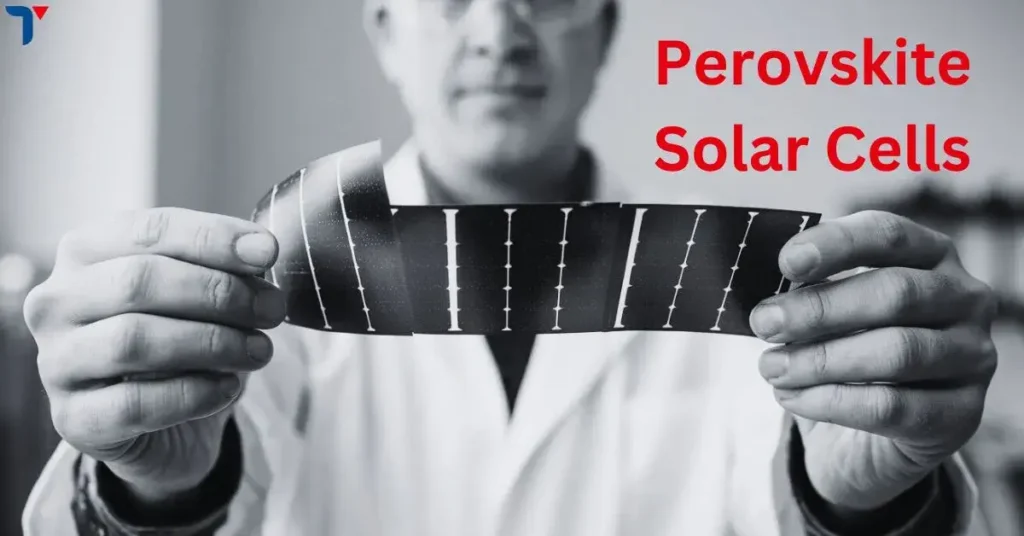
Perovskite solar cells (PSCs) are a new and exciting class of photovoltaic technology that has gained significant attention due to their high efficiency and potential to revolutionize the solar energy landscape. Named after the mineral “perovskite,” these solar cells use a special class of materials with a crystal structure similar to that of calcium titanate (CaTiO₃), first discovered in the 19th century by Russian mineralogist Lev Perovski. The particular perovskite compounds used in solar cells have the general chemical formula ABX₃, where:
- A is an organic or inorganic cation (e.g., methylammonium or cesium),
- B is a metal cation (usually lead or tin),
- X represents a halide anion (such as chloride, bromide, or iodide).
This unique crystalline structure enables perovskites to exhibit remarkable properties that make them ideal for light absorption and energy conversion. Unlike traditional silicon-based solar cells, which require highly pure silicon and energy-intensive manufacturing processes, perovskites can be synthesized using inexpensive and widely available materials. Furthermore, they can be processed at low temperatures, offering the potential for lower-cost production.
Key Properties of Perovskites:
- Strong Light Absorption: Perovskites have a high absorption coefficient, meaning they can capture a significant amount of sunlight even in thin layers.
- High Efficiency: The efficiency of perovskite solar cells has skyrocketed in recent years, with laboratory efficiencies reaching over 25%, making them one of the most efficient solar technologies available.
- Flexibility and Versatility: Unlike rigid silicon wafers, perovskites can be applied as thin films on various surfaces, allowing for flexible, lightweight solar panels and integration into building materials, textiles, and even windows.
- Charge Carrier Mobility: Perovskites exhibit excellent charge carrier mobility, which enables efficient separation and transport of electrons and holes, reducing energy losses during the conversion of sunlight into electricity.
Evolution of Perovskite Solar Cells
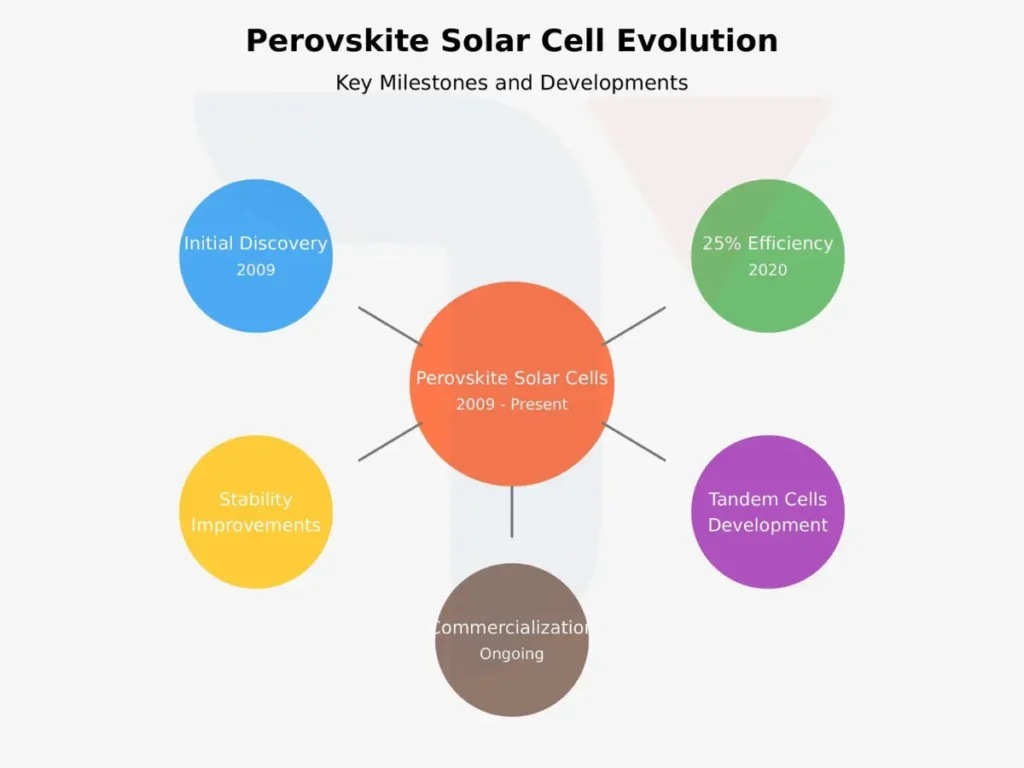
The development of perovskite solar cells began around 2009 when researchers started using perovskite materials as light absorbers in dye-sensitized solar cells. Early iterations of these cells had low efficiencies and poor stability. However, rapid advancements in materials science have led to the significant improvement of PSCs over the last decade. Today, they are considered one of the most promising alternatives to traditional silicon solar panels, and their research has become one of the fastest-growing areas in the field of photovoltaics.
Perovskite solar cells represent a transformative leap in solar energy technology. Their unique crystalline structure, combined with their potential for high efficiency, low-cost production, and flexibility, positions them as a key player in the future of renewable energy. As research continues to improve their stability and scalability, PSCs are likely to play an increasingly vital role in the global shift toward clean, sustainable energy.
How Perovskite Solar Cells Work
Perovskite solar cells (PSCs) operate on the same basic principles as other photovoltaic technologies—converting sunlight into electrical energy. However, the key to their groundbreaking performance lies in the unique structure and material properties of the perovskite layer, which serves as the heart of the device. To understand how PSCs work, it is important to break down the structure and the mechanism by which light is absorbed and transformed into electricity.
- Layered Structure of Perovskite Solar Cells
Perovskite solar cells typically consist of several layers, each with a specific function:- Transparent Conducting Electrode (TCE): This top layer allows light to enter the cell while also conducting the electric current generated. Indium tin oxide (ITO) is commonly used for this purpose.
- Electron Transport Layer (ETL): Situated just beneath the TCE, this layer is designed to facilitate the flow of electrons to the electrode while blocking holes (the absence of electrons). Materials such as titanium dioxide (TiO₂) or zinc oxide (ZnO) are often used here.
- Perovskite Absorber Layer: This is the most crucial layer of the cell. Made of a perovskite-structured compound (commonly lead-based methylammonium lead iodide, MAPbI₃), it absorbs sunlight and generates excitons—pairs of electrons and holes.
- Hole Transport Layer (HTL): Located underneath the perovskite layer, this layer ensures that holes (positive charge carriers) flow towards the electrode while blocking electrons. Organic materials like spiro-OMeTAD are frequently used as hole transporters.
- Metal Electrode: This bottom layer, often made of metals such as gold or silver, collects the current produced and closes the circuit.
- Photovoltaic Process
The energy conversion process in perovskite solar cells follows a sequence of critical steps:- Light Absorption: When sunlight strikes the perovskite layer, it excites the electrons in the material. The perovskite structure is particularly adept at absorbing a broad spectrum of light, including visible and near-infrared wavelengths, thanks to its high absorption coefficient.
- Exciton Generation: Upon absorbing light, the perovskite layer creates excitons—bound pairs of electrons and holes. These are generated within the absorber layer and must be separated to generate electrical current.
- Charge Separation: The perovskite material, unlike many other semiconductors, allows for efficient charge separation. Electrons are transferred to the electron transport layer, while holes move toward the hole transport layer. This charge separation is one of the defining features of perovskites, contributing to their high efficiency.
- Charge Collection: Once separated, the electrons flow through the electron transport layer towards the transparent conducting electrode, and the holes are directed towards the metal electrode. This movement of charges generates a current, which can be collected and used as electrical power.
- Comparison with Silicon Solar Cells
- Efficiency: While traditional silicon solar cells have dominated the market for decades, they are relatively bulky and have lower efficiency limits. In contrast, perovskite solar cells have demonstrated rapidly improving efficiency, with some devices surpassing 25% in laboratory settings.
- Material Properties: Silicon solar cells rely on high-purity silicon, which requires energy-intensive manufacturing processes. Perovskite solar cells, on the other hand, use materials that are cheaper and easier to process at lower temperatures, making them more cost-effective.
- Flexibility: Unlike rigid silicon wafers, perovskites can be deposited onto flexible substrates, allowing for the production of lightweight, bendable, and even transparent solar cells. This opens up new applications, such as integrating solar cells into windows, clothing, or portable devices.
Perovskite solar cells are transforming the way we think about solar energy by offering a novel way to harness sunlight more efficiently and flexibly. Their layered structure and remarkable ability to absorb light and separate charges make them one of the most promising technologies in the pursuit of cost-effective and efficient renewable energy. As research progresses, PSCs are expected to play a central role in expanding the reach and versatility of solar power.
Key Advantages of Perovskite Solar Cells
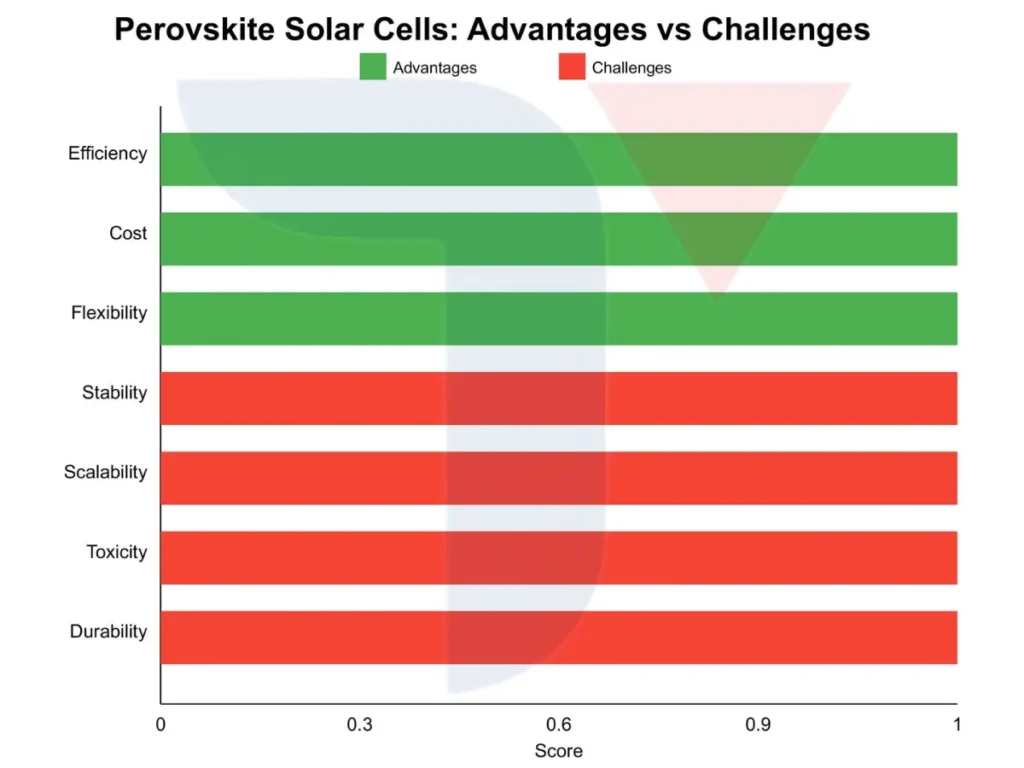
Perovskite solar cells have rapidly emerged as a game-changer in the photovoltaic industry, offering several key advantages over traditional solar technologies. Their remarkable potential lies in their ability to combine high efficiency with cost-effective manufacturing processes, making them a highly attractive option for both commercial and residential solar energy applications. Here are some of the most significant advantages of perovskite solar cells:
- High Efficiency: One of the standout features of perovskite solar cells is their exceptional power conversion efficiency (PCE). Over the past decade, researchers have achieved impressive gains in efficiency, with perovskite cells reaching up to 25.7% in lab settings, a significant improvement over the early days of the technology. These efficiency levels are on par with—and in some cases, surpass—those of traditional silicon-based solar cells. Moreover, perovskite materials exhibit strong absorption across a wide range of the solar spectrum, which further enhances their ability to convert sunlight into electricity.
- Low Cost of Production: Perovskite solar cells offer a more affordable alternative to silicon photovoltaics due to their low-temperature, solution-based processing techniques. These materials can be produced using simple deposition methods such as spin coating, printing, and spray coating, all of which reduce energy costs and enable mass production. Additionally, the raw materials used in perovskite solar cells are more abundant and less expensive than those required for silicon cells, making them a promising option for reducing the overall cost of solar energy.
- Flexibility and Lightweight Design: Unlike rigid, bulky silicon panels, perovskite solar cells can be manufactured on flexible substrates, making them lightweight and adaptable to a variety of applications. This flexibility opens the door to innovative uses such as solar films, wearable solar technologies, and curved surfaces like vehicles or drones. Furthermore, this flexibility enables the creation of semi-transparent solar cells, which can be integrated into windows, facades, or other building materials, leading to the development of building-integrated photovoltaics (BIPV).
- Scalability and Versatility: The versatility of perovskite solar cells allows for easy scalability, from small-scale applications like powering portable electronics to large-scale utility projects. Their ability to be deposited on a wide range of surfaces, including glass, plastic, and metal foils, makes them highly adaptable for different environments. This flexibility not only enhances their scalability but also presents new possibilities for solar energy integration in areas where traditional panels would be impractical.
- Environmental and Sustainability Benefits: In addition to their performance and cost advantages, perovskite solar cells offer potential environmental benefits. Their lower energy requirements for production contribute to a reduced carbon footprint compared to silicon solar cells. Moreover, perovskite materials have a shorter energy payback time—the time it takes for a solar cell to generate the energy required for its manufacturing—making them a more sustainable option in the long term.
As these advantages demonstrate, perovskite solar cells represent a significant step forward in the pursuit of more efficient, affordable, and versatile solar energy solutions. While challenges remain, particularly in terms of long-term stability and commercialization, the continued improvement of perovskite technology holds the promise of transforming the solar energy landscape and enabling a future powered by clean, renewable energy.
Challenges Facing Perovskite Solar Cells
Despite their remarkable potential, perovskite solar cells (PSCs) face several significant challenges that hinder their large-scale adoption and commercialization. While the high efficiency, low cost, and flexible nature of perovskite materials have drawn attention, these benefits are tempered by issues related to stability, scalability, and toxicity. Addressing these challenges is crucial for perovskite solar cells to become a viable mainstream alternative to traditional photovoltaic technologies.
- Stability and Degradation: One of the most pressing issues with perovskite solar cells is their sensitivity to environmental factors such as moisture, heat, and ultraviolet (UV) radiation. Unlike silicon-based solar panels, which can remain operational for decades, perovskite solar cells degrade rapidly when exposed to ambient conditions. Moisture, in particular, can penetrate the perovskite layer and lead to decomposition, drastically reducing the cells’ efficiency and lifespan. Thermal instability is another challenge, as high temperatures can cause phase transitions within the perovskite material, negatively affecting its performance. Researchers are actively working on improving the stability of PSCs through encapsulation techniques and material innovations, but long-term durability remains a major hurdle.
- Scalability and Manufacturing: While perovskite solar cells have demonstrated high efficiency in lab-scale experiments, scaling up the technology to commercial production poses significant challenges. The manufacturing process for PSCs involves solution-based techniques that, while cost-effective, are difficult to control consistently on an industrial scale. Issues such as uniformity of the perovskite layer, defects in large-area cells, and reproducibility of results have yet to be fully resolved. Additionally, the integration of PSCs into existing manufacturing lines and solar panel systems is not straightforward, requiring new equipment and processes that add complexity and cost.
- Toxicity Concerns: A critical issue in the development of perovskite solar cells is the presence of lead in the most efficient perovskite formulations. Lead is a highly toxic heavy metal, raising concerns about the environmental and health impacts of widespread PSC deployment. While encapsulation can mitigate the risk of lead leakage, there are still concerns about disposal and potential contamination if damaged cells are improperly handled. The search for lead-free alternatives has been ongoing, with some promising results, but lead-free perovskites have so far not achieved the same level of efficiency as their lead-based counterparts.
- Ongoing Research and Potential Solutions: To address these challenges, ongoing research is focused on several key areas. Efforts to improve stability include developing new encapsulation methods and exploring alternative materials that are less sensitive to environmental stressors. In terms of scalability, innovations in roll-to-roll manufacturing and vapor deposition techniques offer promising solutions for large-scale production. Meanwhile, researchers are working on lead-free perovskite compounds such as tin-based perovskites, though these materials still face challenges in terms of efficiency and stability. Collaborative efforts between academia, industry, and government institutions are essential to overcoming these barriers and unlocking the full potential of perovskite solar cells.
While perovskite solar cells hold great promise for the future of renewable energy, significant technical and environmental challenges must be addressed before they can achieve widespread commercial viability. With continued research and development, however, many of these obstacles may eventually be overcome, paving the way for a new generation of solar technologies.
Latest Research and Innovations
Perovskite solar cells have undergone rapid development, driven by a wave of scientific breakthroughs and engineering innovations. Over the past decade, the efficiency of perovskite solar cells has skyrocketed, with some laboratory cells now exceeding 25% efficiency—rivalling traditional silicon-based cells. Much of this progress can be attributed to improved understanding of perovskite material properties and the development of novel fabrication techniques. Recent research highlights several key areas of innovation that are helping perovskite solar cells move closer to large-scale commercial viability:
- Efficiency Improvements: One of the most exciting developments in perovskite solar cell technology is the achievement of record-breaking power conversion efficiencies. Researchers have fine-tuned the chemical composition of perovskite materials to enhance their ability to absorb sunlight and convert it into electricity. Advanced compositional engineering, such as the incorporation of mixed-halide perovskites, has played a pivotal role in boosting efficiency levels. Additionally, optimization of the perovskite layer thickness and the use of novel interfacial materials have minimized energy losses, further improving cell performance.
- Tandem Cells: A significant leap forward has been made with perovskite-silicon tandem cells. By stacking a perovskite layer on top of a traditional silicon solar cell, researchers have been able to capitalize on the strengths of both materials. These tandem cells have surpassed the efficiency limits of silicon cells alone, achieving efficiencies above 30%. This hybrid approach is particularly promising because it leverages existing silicon manufacturing infrastructure while introducing the superior light-absorption properties of perovskites.
- Stability Enhancements: Stability has long been a critical challenge for perovskite solar cells, with early versions degrading rapidly when exposed to moisture, heat, and ultraviolet light. However, recent advancements have led to the development of more stable perovskite compositions, as well as improved encapsulation techniques that protect the cells from environmental factors. For example, the use of 2D perovskites as a protective layer on top of the 3D perovskite structure has significantly increased durability, enabling solar cells to maintain high efficiency over longer periods.
- Lead-Free Perovskites: Although lead-based perovskites have demonstrated exceptional efficiency, concerns over lead toxicity have prompted researchers to develop safer alternatives. Lead-free perovskites, such as tin-based variants, are being actively explored as non-toxic substitutes. While these materials currently lag behind lead-based perovskites in terms of efficiency and stability, ongoing research is focused on closing this performance gap through chemical modification and material engineering.
- Roll-to-Roll Manufacturing: Manufacturing scalability remains one of the key challenges for perovskite solar cells. Roll-to-roll (R2R) processing—a technique borrowed from the printing industry—offers a potential solution. This low-cost, high-throughput manufacturing method enables the production of large-area perovskite films on flexible substrates, paving the way for mass production. Researchers are refining the R2R process to ensure that it can deliver uniform, high-quality films without compromising the efficiency or stability of the cells.
- Flexible and Transparent Solar Cells: The inherent flexibility of perovskite materials has led to the development of flexible solar cells that can be integrated into wearable electronics, portable devices, and curved surfaces. Additionally, transparent perovskite solar cells are being explored for applications in building-integrated photovoltaics (BIPV), where they could be embedded into windows and façades, allowing buildings to generate their own electricity without sacrificing aesthetics.
The pace of innovation in perovskite solar cells is accelerating, with researchers continuing to push the boundaries of what is possible in terms of efficiency, stability, and scalability. These advancements are not only bringing us closer to the commercialization of perovskite technology but also expanding the range of potential applications, from high-performance solar farms to everyday consumer products. As these innovations converge, perovskite solar cells are set to play a transformative role in the future of renewable energy.
Commercialization of Perovskite Solar Cells and Future Prospects
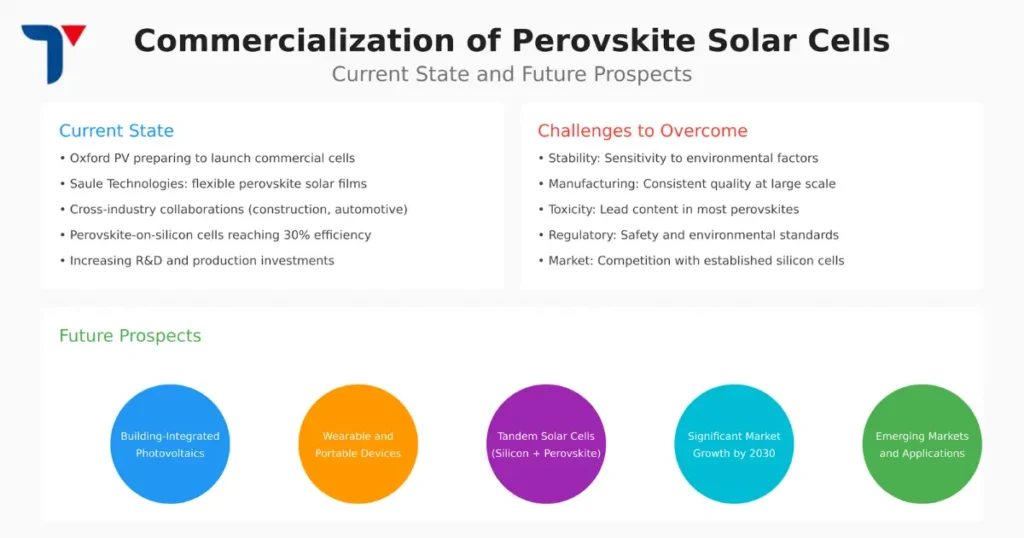
The commercialization of perovskite solar cells (PSCs) has accelerated rapidly over the last few years, with research breakthroughs translating into tangible, market-ready products. These developments are driven by the material’s high efficiency, low production costs, and the ability to integrate perovskite cells into a range of new applications that traditional silicon cells cannot support. Despite the remaining challenges, such as stability and large-scale manufacturing, companies and research institutions are pushing forward with ambitious plans to bring PSCs into mainstream use. Below, we outline the current landscape and future prospects for PSC commercialization:
- Current State of Commercialization:
Several companies have already made significant strides in moving PSCs from the lab to the market. UK-based Oxford PV, a leader in perovskite technology, is preparing to launch its first commercial perovskite-on-silicon tandem solar cells. These cells have the potential to exceed 30% efficiency, outperforming standard silicon panels. Meanwhile, Saule Technologies in Poland is exploring new applications of flexible perovskite solar films, suitable for integration into everything from wearable electronics to architectural glass. The versatility of perovskites has led to collaborations across industries, including construction, automotive, and consumer electronics. - Challenges to Overcome:
Despite the excitement, PSCs face several barriers before achieving widespread commercialization:- Stability: Perovskite cells are sensitive to environmental factors like moisture, heat, and ultraviolet radiation, which can cause degradation over time.
- Manufacturing Scale: Scaling up the production of perovskite solar cells while maintaining consistent quality and efficiency is still a challenge.
- Toxicity Concerns: The lead content in most perovskite materials poses environmental and regulatory challenges, prompting ongoing research into lead-free alternatives.
- Leading Companies and Institutions:
Beyond Oxford PV and Saule Technologies, several other key players are contributing to the commercialization of PSCs:- Hunt Perovskite Technologies: Focuses on producing durable, stable perovskite solar cells that can meet commercial standards.
- GCL-Poly: A Chinese company developing large-scale production lines for perovskite modules.
- Solliance: A consortium of European research institutions working on scaling up production of perovskite modules and integrating them into building materials.
- Future Prospects:
The future of perovskite solar cells is bright, with several potential applications beyond conventional solar panels:- Building-Integrated Photovoltaics (BIPV): Perovskite cells can be incorporated into windows, façades, and other building materials, turning urban infrastructure into energy-generating surfaces.
- Wearable and Portable Devices: Thanks to their lightweight and flexible nature, perovskite cells can be used to power portable electronics, smartwatches, and even clothing.
- Tandem Solar Cells: By combining perovskites with traditional silicon cells, manufacturers can create tandem cells that surpass the efficiency limits of either technology on its own, making solar energy more accessible and competitive.
- Market Growth and Adoption:
The perovskite solar cell market is expected to grow significantly over the next decade. According to industry forecasts, the global PSC market could reach a valuation of several billion dollars by 2030. This growth is driven by increased investment from both the public and private sectors, the demand for more efficient solar technologies, and the ongoing development of new applications, particularly in regions with emerging markets for renewable energy.
As PSC technology matures, it holds the potential to disrupt the global solar market, offering cost-effective, high-efficiency alternatives to existing solar solutions. While challenges remain, ongoing research and innovation promise to unlock the full potential of perovskite solar cells, pushing them into new markets and applications that could transform the way we think about solar energy generation in the years to come.
Comparative Analysis with Other Emerging Solar Technologies
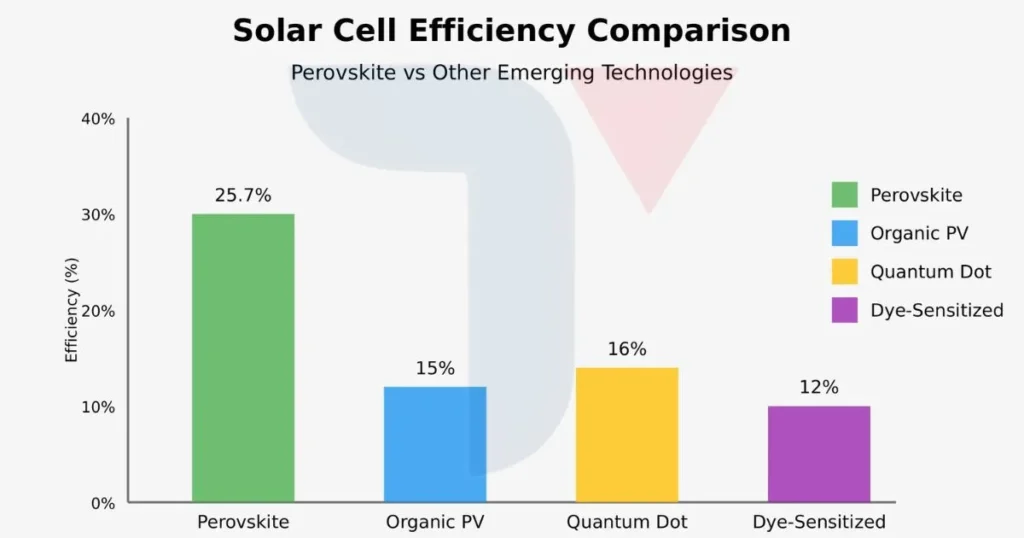
As the quest for improved solar energy solutions continues, various emerging photovoltaic technologies are gaining traction alongside perovskite solar cells (PSCs). Each of these technologies offers unique advantages and faces distinct challenges, influencing their potential role in the future of renewable energy. Below, we compare perovskite solar cells with some of the most promising alternatives: organic photovoltaics, quantum dot solar cells, and dye-sensitized solar cells.
Organic Photovoltaics (OPVs):
- Efficiency and Performance: OPVs have seen gradual improvements in efficiency, currently reaching around 12-15%, still lower than PSCs, which have already achieved over 25% efficiency in lab settings. Organic materials, however, excel in flexibility, making them ideal for wearable devices and portable applications.
- Cost and Manufacturing: Organic solar cells are lightweight and can be produced using low-cost, solution-based techniques similar to printing. Like perovskites, they offer potential for inexpensive large-scale production, but they generally suffer from lower power conversion efficiency.
- Stability and Lifespan: OPVs face significant challenges regarding stability, with organic materials prone to degradation under prolonged exposure to sunlight and oxygen. This issue is shared with perovskite cells, but current research shows that PSCs may offer better long-term stability as new encapsulation and material improvements are developed.
Quantum Dot Solar Cells (QDSCs):
- Efficiency and Performance: QDSCs leverage nanostructures that offer tunable bandgaps, allowing them to absorb different wavelengths of light. While this versatility is promising, their current efficiency is lower than that of PSCs, typically ranging between 12-16%.
- Unique Applications: Quantum dots excel in unique niche applications due to their flexibility, such as in semi-transparent solar panels or in tandem cells combined with other photovoltaic technologies like silicon or perovskites.
- Challenges: Like PSCs, quantum dots face challenges in achieving stability and scalability. Furthermore, toxic materials, such as cadmium, are often used in quantum dots, which pose environmental and regulatory concerns similar to the lead issues associated with some perovskite cells.
Dye-Sensitized Solar Cells (DSSCs):
- Efficiency and Performance: DSSCs offer lower efficiency compared to PSCs, typically around 10-12%. However, their efficiency can be maintained even under low light conditions, making them suitable for indoor applications or regions with less intense sunlight.
- Manufacturing: DSSCs are cost-effective and relatively easy to produce, using abundant materials. They are often transparent, lending themselves well to applications such as window-integrated solar panels.
- Durability: Like perovskites, DSSCs suffer from stability issues, particularly in outdoor environments. Their liquid electrolyte layer is vulnerable to leakage and degradation over time, though recent advancements are targeting solid-state alternatives to improve longevity.
Comparison Summary:
- Efficiency: Perovskite solar cells lead in efficiency among these emerging technologies, with their rapid improvement trajectory surpassing the current capabilities of OPVs, QDSCs, and DSSCs.
- Cost and Flexibility: All technologies share the potential for low-cost production through solution-based methods, but OPVs and PSCs show the most promise for scalable, flexible applications.
- Stability and Environmental Impact: PSCs are closing the gap in stability, though challenges remain. Quantum dots and PSCs both face environmental concerns due to toxic materials, while DSSCs and OPVs offer more eco-friendly alternatives.
Future Outlook: The race to dominate the next generation of solar technology is far from settled. Perovskite solar cells currently lead in efficiency and versatility, particularly as tandem cells, yet OPVs, QDSCs, and DSSCs each hold unique advantages in specialized applications. As research continues, the most likely outcome is not the dominance of a single technology but rather a convergence of multiple solutions, each tailored to specific needs, from rooftop solar panels to portable electronics and building-integrated systems.
Environmental and Economic Impact
The rise of perovskite solar cells (PSCs) presents not only a technological breakthrough but also significant environmental and economic implications. As the world transitions to more sustainable energy sources, it is essential to assess how new technologies like PSCs contribute to global environmental goals and whether they offer economic advantages over established systems like silicon-based photovoltaics.
Environmental Impact Perovskite solar cells have the potential to reduce the environmental footprint of solar power in several key areas:
- Lower Energy Payback Time: Due to their simpler manufacturing processes and lower material demands, PSCs have a shorter energy payback time compared to traditional silicon solar cells. This means they can generate more energy over their lifecycle relative to the energy required to produce them.
- Reduced Carbon Footprint: PSCs are made using solution-based processes, which often occur at lower temperatures than those used in silicon cell production, reducing overall energy consumption and CO2 emissions during manufacturing.
- Sustainable Material Use: Perovskites rely on abundant materials, including elements like lead (though lead-free alternatives are in development), which decreases reliance on rare and expensive resources. Ongoing research into eco-friendly substitutes aims to eliminate the use of toxic materials without compromising efficiency.
- Potential for Recycling and Reuse: With advancements in manufacturing techniques, the potential for recycling components of perovskite cells is growing. This could contribute to a circular economy where materials are reused rather than discarded, minimizing waste.
However, PSCs still face some environmental challenges:
- Lead Toxicity Concerns: While perovskite cells demonstrate superior efficiency, many use lead-based materials. If improperly disposed of, these materials could pose risks to ecosystems and human health. Current research is focused on developing lead-free alternatives or strategies to safely encapsulate the lead, preventing its release into the environment.
- Longevity and Waste: The relatively short lifespan of perovskite solar cells, compared to silicon cells, can lead to more frequent replacements and potential waste. Researchers are working to enhance their stability and extend their operational life to address this issue.
Economic Impact Economically, perovskite solar cells hold great promise in driving down the costs of solar energy, making it more accessible to consumers and industries worldwide:
- Lower Manufacturing Costs: Perovskite solar cells can be produced using low-cost, solution-processed methods such as inkjet printing, roll-to-roll coating, or spray deposition. These techniques are not only more energy-efficient but also less capital-intensive than the high-temperature, energy-hungry processes used for silicon cells.
- Higher Energy Output for Lower Investment: With their potential for higher efficiency at lower costs, PSCs could significantly reduce the price per watt of solar power. This makes solar energy more competitive with fossil fuels and accelerates the transition to renewable energy.
- Flexibility in Application: The lightweight and flexible nature of perovskite solar cells expands their use beyond conventional solar panels. They can be integrated into windows, rooftops, and even wearable devices, broadening the market for solar technology and creating new economic opportunities.
- Market Growth Potential: As perovskite technology continues to advance, the market is expected to grow rapidly. The ability to manufacture PSCs at scale will be a key driver of this growth, enabling mass production and lower costs, which in turn may increase global adoption of solar energy across residential, commercial, and industrial sectors.
The environmental and economic impacts of perovskite solar cells suggest that they have the potential to reshape the solar industry. Environmentally, they promise a smaller carbon footprint and faster energy payback, but concerns about material toxicity and longevity remain challenges to be addressed. Economically, PSCs offer a pathway to cheaper, more versatile solar power, expanding market opportunities and accelerating the transition to renewable energy. As ongoing research tackles the remaining hurdles, perovskite solar cells could play a pivotal role in achieving global sustainability goals and making solar energy the dominant power source of the future.
Conclusion
Perovskite solar cells (PSCs) represent a major breakthrough in the quest for more efficient and accessible renewable energy technologies. As the world continues to grapple with the consequences of climate change and seeks cleaner energy solutions, PSCs have emerged as a frontrunner in the next generation of solar power.
Their rapid rise is driven by several key factors: they offer high efficiency at a low cost, are relatively easy to produce, and have the flexibility to be used in a wide range of applications—from traditional rooftop panels to innovative solutions like building-integrated photovoltaics and flexible solar devices. Despite these impressive advancements, challenges remain. The long-term stability of perovskite materials, their sensitivity to environmental factors such as moisture and heat, and concerns over the toxicity of lead-based perovskites continue to be areas of active research. However, ongoing innovations in encapsulation techniques, lead-free alternatives, and tandem cell designs are steadily improving the durability, safety, and scalability of PSCs.
Looking forward, the commercialization of perovskite solar cells is progressing, with several companies and research institutions advancing closer to bringing these technologies to the mass market. As improvements in manufacturing processes continue, including cost-efficient roll-to-roll printing and increased production scales, PSCs could become a cornerstone of global renewable energy systems. Their potential to significantly reduce the costs of solar energy, coupled with their versatility in various applications, makes them a compelling solution for meeting global energy demands.
In summary:
- Transformative potential: Perovskite solar cells offer a pathway to more affordable, efficient, and versatile solar technologies.
- Ongoing challenges: Stability, toxicity, and scalability issues remain but are being actively addressed through research and development.
- Future outlook: With continued progress in materials science and manufacturing, PSCs are well-positioned to play a key role in the future of renewable energy, contributing to global efforts to mitigate climate change and transition to a sustainable energy future.
The road ahead for perovskite solar cells is filled with both promise and obstacles, but their potential to reshape the solar industry is undeniable. As researchers refine the technology and commercial products begin to hit the market, PSCs could fundamentally alter how we harness the sun’s power, opening up new frontiers in clean energy.

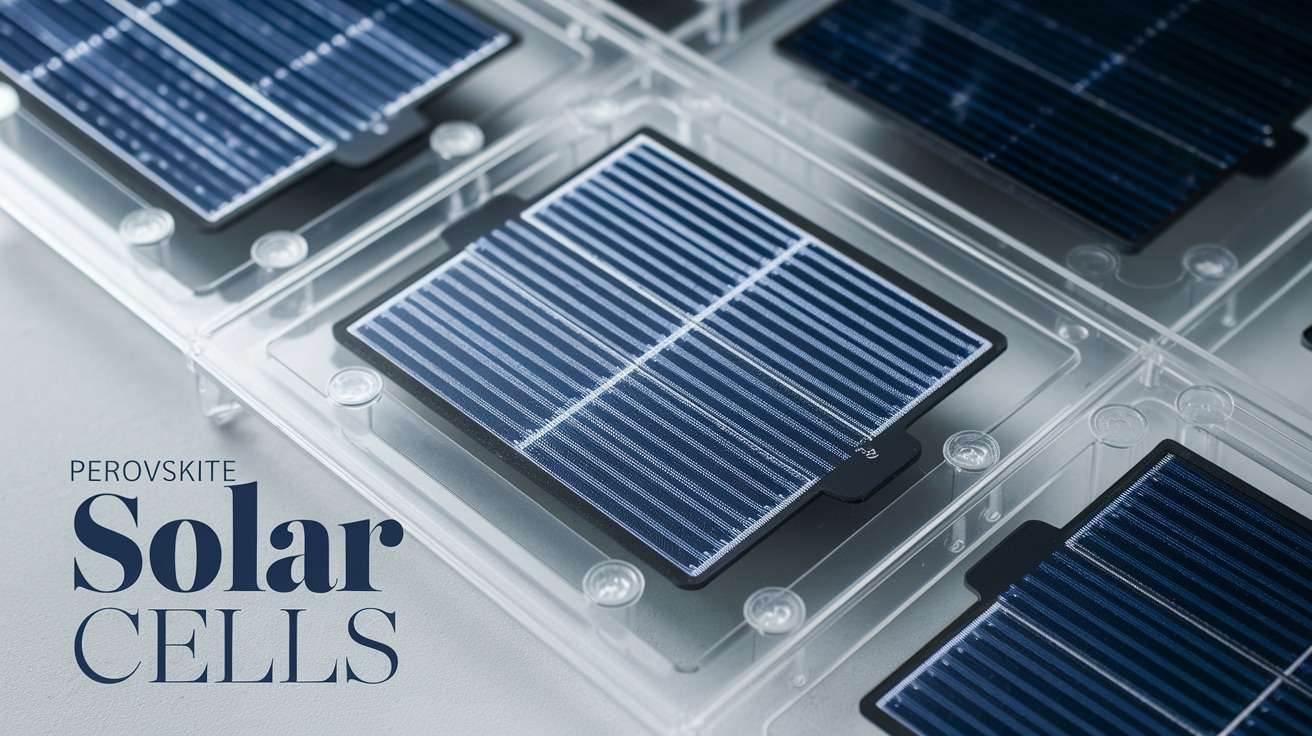
1 thought on “Perovskite Solar Cells in 2024: High Efficiency & Bright Future”
Comments are closed.